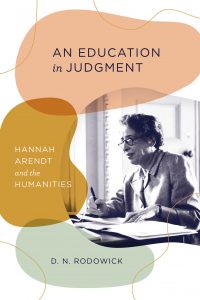In An Education in Judgment: Hannah Arendt and the Humanities, D.N. Rodowick draws on Hannah Arendt’s writings on judgment to make the case for a philosophy of the humanities grounded in self-reflection and interpersonal exchange. This innovative and plausible thesis of an education in judgment as the unifying element of the humanities will likely trigger fruitful debate, writes Mario Clemens.
An Education in Judgment: Hannah Arendt and the Humanities. D.N. Rodowick. University of Chicago Press. 2021.
 Find this book (affiliate link):
Find this book (affiliate link):![]()
What do people studying in the humanities (including languages, philosophy, arts and more) actually learn? This is the question underlying David Norman Rodowick’s new book, An Education in Judgment, where he continues his project of formulating a ‘philosophy of the humanities’.
So, what do they learn? For Rodowick – artist, curator and Glen A. Lloyd Distinguished Service Professor in the College and the Division of Humanities at the University of Chicago – the crucial thing students in departments such as his receive is ‘an education in judgment’. Given the range of different disciplines gathered under the broad roof of the humanities, an education in judgment can take many forms. The example Rodowick offers from his own work context has the merit of being especially plastic and vivid.
At the Department of Visual Arts at the University of Chicago, students and staff regularly meet for a whole day to discuss works of art by students. All participants in such critique sessions will, for instance, stand around a three-dimensional object. They take some time to look at it from various sites, take in the material, its texture, the colouring, the shapes, etc, to finally form an initial opinion. Crucially, what they see is determined not only by the object as such but also by what they make of it, ‘the physical process of seeing is inseparable from imaginative processes of understanding’ (152).
How each viewer processes the incoming sense data and, quite literally, makes sense of an object will depend on a variety of socio-cultural factors. For instance, people’s upbringing, past aesthetic experiences or their knowledge of art history all play their role in the sense-making process. However, since those factors shape each individual’s imaginative process of understanding, it will change once they are altered. This happens regularly when we reflect on our own judgments and when we expose ourselves to the judgments of others.
Thus, while the piece of art as a physical object will remain the same during a critique session, ‘artful conversation with others encourages me to frame it in different contexts or to see it from different perspectives, its possibilities of sense and value shift – for me it becomes a new work; I see it differently, and accordingly I revise my opinion’ (152). This raises interesting philosophical questions, such as whether my view of an object at the end of such a critique session is more accurate than my initial impression. Is there, in other words, an objective standard that would allow us to compare the quality of judgments? And if not, what would be the point of conducting critique sessions or – looking at a different branch of the humanities – discussing philosophical texts? If we cannot measure the quality of judgments, what’s the point of an education in judgment?

Image Credit: Crop of Barbara Niggl Radloff, Hannah Arendt at the 1st Cultural Critics Congress, 1958, gelatine developing paper (PE), 30.3 cm x 23.8 cm, Munich City Museum, Photographic Collection, Barbara Niggl Radloff Archive. https://sammlungonline.muenchner-stadtmuseum.de /object/hannah-arendt-at-the-1-culture-critic-congress-10218949. Licensed under CC BY SA 4.0.
Rodowick approaches these and related questions by undertaking ‘close philosophical readings’ (xiv) of Hannah Arendt’s writings of the last decade of her life (1965-75), where she was increasingly concerned with the human faculty of judgment. As Immanuel Kant and later Arendt have shown, aesthetic and political judgments (the two types Rodowick is concerned with) are both of the ‘reflective’ type. While ‘determinant judgments’ result from subsuming a particular case (for example, a deed) under an agreed-upon rule (for example, judicial law), there is no such rule available in the case of ‘reflective judgments’.
Of course, it is easy to think of particular arguments supporting a singular judgment. And to the degree that a given audience finds these arguments persuasive, it will think of a given judgment as sound. However, even in the (somewhat unlikely) case of unanimous agreement on the most persuasive take on a piece of art or text, such a judgment and its supporting arguments will be challenged from another perspective once time has passed or the composition of the discourse community has altered. Thus, there is no way to determine the objective quality of judgments – at least on a content level.
This is bad news if we are determined to find the accurate interpretation of a painting or identify the correct reading of a text. It does not render the exercise of reflective judgment pointless though. If we shift the focus, we can see that the exchange of judgments is serving a vital purpose.
Even though there are no objective standards at our disposal when it comes to reflective judgments, we paradoxically utter such judgments in the hope (or expectation) that others will agree. At the level of the individual, this human impulse to share one’s view of the world with others and the hope for approval leads people to consider others’ perspectives and incorporate them in their judgments: ‘the less idiosyncratic and the more impartial one’s judgment, the better it can be represented to others’ (92).
On a social level, the effect is that the public utterance of opinion (the act of judgment) allows people to create and maintain what Arendt calls a ‘common world’. Why this should be so can be seen in the example above. What a piece of art is is not predetermined by its physical features alone but is the result of ongoing negotiations about meaning and value. And this is true not only of pieces of art but all culture, understood in the broad Weberian sense of all parts of the world that humans have endowed with meaning. What is at stake, then, in the exchange of opinion is not only negotiation about the meaning of a given object but also our ways of understanding and seeing the world. ‘The contributions of each participant [of a critique session] subtly shift the descriptive language of the community and, therefore, our ways of seeing and understanding’ (153).
This explains why even people who are aware that the practice of exchanging judgments will not get them closer to the truth nonetheless have good reasons to continue that practice. However, we are still left with the original question. What does an ‘education in judgment’ aim at, if not improving people’s ability to make sound judgments?
Rodowick seems to suggest that the humanities teach hermeneutic skills that are useful in the open-ended project of determining our mutual world. Thus, although Rodowick cites Arendt and Kant as his two key reference points, Socrates turns out to be the book’s real hero. While Socrates famously had no positive doctrine to teach, he is the best teacher for the dialogue we need to engage in to understand better our own opinions, including their yet unexamined premises and how others came to the beliefs they hold.
While there are no standards to determine the quality of a judgment as such, it does seem possible to identify procedural standards and criticise judgments with reference to how they have (presumably) been reached. Rodowick appears hesitant to take this step, however. He holds that there is nothing graspable that can be taught and that students and teachers stand essentially on one level while exchanging their judgments:
Perhaps I have rehearsed my powers of judgment for longer than my students; this gives me experience, and perhaps I can pass that experience along by example, but my experience does not make my judgments or opinions necessarily better than those of my students. (155)
However, on various occasions in the book, Rodowick does direct us to procedural standards. For example, he refers at one point to ‘the qualities of right judgment’, which for him include ‘discernment, insight, impartiality, representative thinking, critical self-consciousness or self-awareness, openness to revisability, and generosity or fellow feeling’ (139). Those and other criteria (which all centre around the need to take multiple views into account) surely need interpretation. They are not sufficient to reach an agreement in all cases where two contrasting judgments compete for approval. However, they might help to weed out the most severe cases of poor judgment. If so, awareness of and adherence to such standards would be a critical hallmark for an education in judgment.
Anyone seeking orientation in the scholarly debates about judgment will be ill-served by this book, which Rodowick intended to write in the tradition of the French essay, with no attempt to connect thoughts systematically to existing works in the field. At the same time, his innovative and plausible thesis of an education in judgment as the unifying element of the humanities will likely trigger fruitful debate and – as is to be expected – with an open end.
- This review first appeared at LSE Review of Books.
- Please read our comments policy before commenting.
- Note: This article gives the views of the author, and not the position of USAPP – American Politics and Policy, nor of the London School of Economics.
- Shortened URL for this post: https://bit.ly/3V5tbkN






